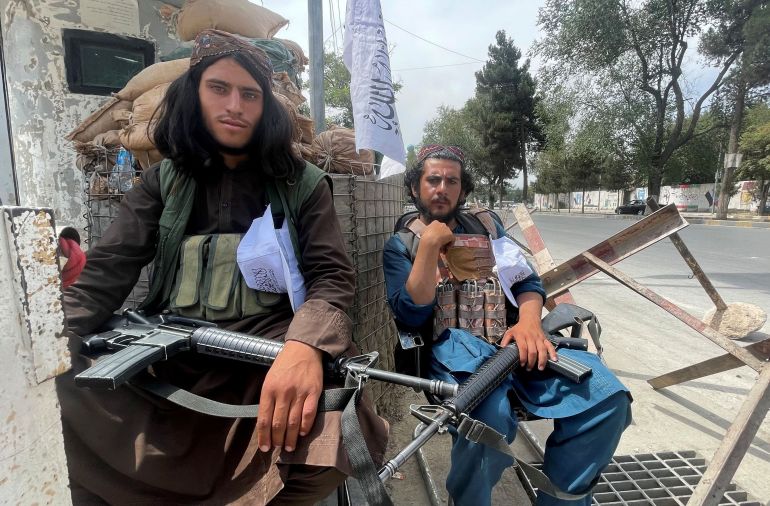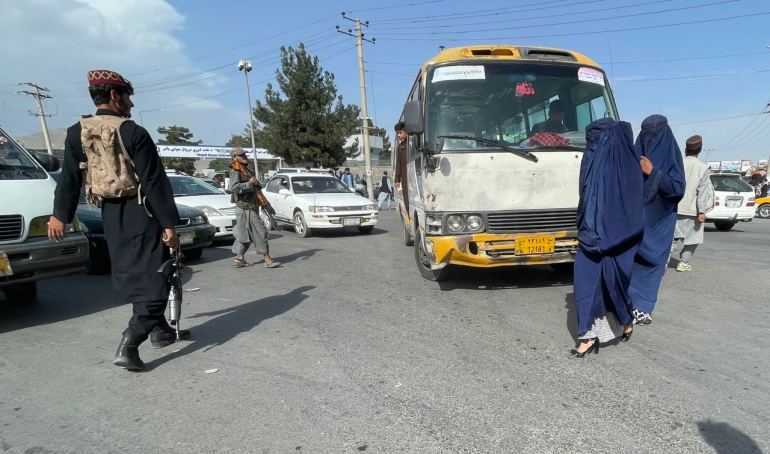The Taliban took control of Afghanistan last week, 20 years after it was overthrown by a US-led military invasion.
Winning the war may turn out to be an easy part as maintaining the peace and ruling the conflict-ridden and impoverished country will be a tough nut to crack, analysts and Afghan officials say.
Al Jazeera takes a look at six challenges the armed group faces as it prepares to rule the 38-million country for the second time since 2001.
adoption
The government of President Ashraf Ghani has not been able to meet the wishes of the people, as poor basic services such as health and education have barely improved their standard of living.
The government was stuck in corruption, while the security situation remained fragile and thousands of Afghans had to leave the country. Many notorious militia leaders and their henchmen have been rehabilitated despite their appalling human rights violations and corruption.
People carry the national flag during a protest during Afghan Independence Day in Kabul [File: Reuters]
People were frustrated and ready for change, but that doesn’t mean they welcome the return of the Taliban.
“In many parts of Afghanistan, people are faced with the choice of a repressive Taliban regime or a government that gets far more than it delivers,” said Jonathan Schroden, head of research at the Center for Naval Analyzes, based in the US state of Virginia.
“While some Afghans certainly have strong preferences and support one side over the other, many are caught not being particularly enthusiastic about either side,” said Schroden, who heads the Countering Threats and Challenges program.
Stretched forces
Within weeks, the armed group captured most of the provincial capitals, including the capital Kabul, in a virtually unilateral, lightning-fast military strike that brought back memories of US-trained Iraqi troops who fled battlefields in 2014 in the face of marauding ISIL fighters.
The Taliban launched their military offensive in May when US-led foreign troops began under an agreement the group signed with the US on February 29, 2020 in the Qatari capital, Doha.
The Afghan security forces either surrendered (after mediation by local tribal elders) or withdrew, which caused an attack by the Taliban fighters in some northern and western provinces.
Advisors to the previous administration of President Ghani, who has since fled the country, say the former government’s decision to withdraw government troops from remote areas backfired as it allowed the Taliban to gain momentum and move the remaining troops in To put fear.
 Taliban fighters patrol Kabul [Rahmat Gul/AP Photo]
Taliban fighters patrol Kabul [Rahmat Gul/AP Photo]
Now with almost all of Afghanistan under their control and fewer than 100,000 active fighters, the Taliban are few and far between, analysts say.
“The Taliban found it easy to capture a large number of districts, but holding onto large cities is another proposal – one that requires significant labor,” said Schroden.
A former Afghan minister told Al Jazeera that the Shughnan district in Badakhshan province has been occupied by only “six Taliban fighters” – an estimated 60,000 people live there. And there have been other instances when a handful of fighters could conquer significant territory. This has also been confirmed by the Taliban.
The Taliban have announced a general amnesty for government officials in order to keep as many people as possible in their current functions.
If the number of law enforcement agencies is not increased, the country is vulnerable to civil unrest and lawlessness.
Meanwhile, former Vice President Amrullah Saleh and Ahmad Massoud – son of Tajik mujahideen commander Ahmad Shah Massoud – have already called for a challenge to Taliban rule.
guide
The Taliban were good at one thing – fighting. How will they rule this diverse country with almost negligible modern infrastructure?
“The Taliban have yet to demonstrate their ability to govern effectively. They didn’t do this when they ruled Afghanistan, and they haven’t shown such ability in the areas they currently control in the country, ”said Schroden of CNA.
 A Taliban fighter walks past a beauty parlor with pictures of women spraying paint in Shar-e-Naw, Kabul. have been defaced [Wakil Kohsar/AFP]
A Taliban fighter walks past a beauty parlor with pictures of women spraying paint in Shar-e-Naw, Kabul. have been defaced [Wakil Kohsar/AFP]
The Taliban are sometimes credited with being good at maintaining security – albeit by very clumsy means – and providing efficient forms of traditional justice, but they have little to no technocratic understanding of how to perform the other government functions.
The group will likely struggle to provide effective governance to the people of the country as the government cannot spend a lot of money on public services – this is at the core of their problems today.
“There are problems with maintaining enough manpower, bureaucracy and civil servants to manage government affairs. If there is a brain drain, a vulnerability could be an insufficient number of professionals and people in the technocratic cadre to run government institutions, ”said Omar Samad, senior fellow at Atlantic Council.
Control of his powers
The war against a foreign occupation united the rank of the Taliban. If these fighters become governors and mayors, and have access to revenue and powers, will they take the same path that previous governments have taken and end up being accused of corruption and abuse of power?
 Members of the Taliban troops sit at a checkpoint in Kabul [File: Reuters]
Members of the Taliban troops sit at a checkpoint in Kabul [File: Reuters]
“That will be an interesting dynamic to watch. This is what the mujahideen had to struggle with after the Soviet retreat, when they no longer had the unanimous reputation of defeating the godless communists and turning their weapons against each other, ”said Schroden, referring to the war against the Soviet occupation in the 1980s.
“The Taliban are aware of this risk and have spent the last seven or more years improving the vertical and horizontal links within their organization in order to strengthen their cohesion. To what extent these efforts will prevent Taliban fighters from stopping the fight once the rallying call from foreign invaders is gone remains to be seen, “he said.
The past
The last term of the Taliban between 1996 and 2001 was marked by abuse of ethnic minorities and restrictions on women’s rights, while the country was internationally isolated.
Since regaining power on August 15, the Taliban have spoken of, among other things, respect for the role of women in public, human rights and the rights of minorities. But the world and especially the Afghans are waiting to see whether these words will be put into practice.
The US invaded Afghanistan in 2001 because of its ties to al-Qaeda that led to the 11th Qaeda and ISIL attacks.
“Afghan history over the past 50 years has been full of the rise and fall of regimes and governments. Very few had a second chance, and when they did – like the mujahideen – they were short-lived, “Samad, a former diplomat and advisor to the Afghan government, told Al Jazeera.
“You face the great challenge of ensuring an acceptable level of human rights and gender rights policy, media and civil society laws, ethnic rights and minority rights. Visibly breaking off ties to militant and terrorist groups. Time will tell if any of these lessons have been learned. “
Economy and dependence on foreign aid
Afghanistan is one of the poorest countries in the world and more than 20 percent of its gross income comes from development aid.
In the wake of the Taliban takeover, the US frozen US $ 9.5 billion in assets from the Afghan central bank, while the International Monetary Fund (IMF) suspended access to its funds.
Many other Western donors could follow suit, making it extremely difficult for the new government to run the economy in a country where 75 percent of public spending comes from grants.
 Afghans stand in line while waiting for their turn to withdraw money from an ATM in front of a roadside bank in Kabul. to pick up [AFP]
Afghans stand in line while waiting for their turn to withdraw money from an ATM in front of a roadside bank in Kabul. to pick up [AFP]
Significant mineral resources remain underground as instability has prevented large-scale exploration and international investment.
Although the Taliban have discussed possible economic cooperation projects with Russia and China, it remains to be seen how these will be implemented.
It would also take humanitarian aid organizations to provide urgent aid to the Afghans displaced by the war. It is estimated that more than 5 million Afghans are internally displaced. This year alone, according to the United Nations, almost 400,000 people were displaced due to the ongoing violence.
But as aid agencies, including the UN, are pulling their staff out of the country, it becomes difficult for people who depend on foreign aid.
To unlock international funding, recognition of a Taliban government by the international community will be vital as the group is still blacklisted by the UN.
 Taliban patrol the Afghan capital Kabul [Haroon Sabawoon/Anadolu]
Taliban patrol the Afghan capital Kabul [Haroon Sabawoon/Anadolu]
The Taliban shrugged off the idea of relying on foreign aid, stating that their fighters survived the War of Water and Bread. The question remains: can it convince millions of Afghan civilians to live without years of foreign aid?
It is also an opportunity for foreign donors and aid agencies to convince the Taliban to accept their terms in exchange for aid.
But Jonah Blank, a lecturer at the National University of Singapore, said, “Money is not really as powerful a tool as some outsiders might think.”
“As long as it [Taliban] If you have enough money to do its basic ‘job’ (as it sees it), I don’t care if an extra billion or two comes into the treasury here or there, “Blank told Al Jazeera’s’ Counting the Cost ‘Show.












/cloudfront-us-east-2.images.arcpublishing.com/reuters/JEUL2B5V7BJCFMRTKGOS3ZSN4Y.jpg)



/cloudfront-us-east-2.images.arcpublishing.com/reuters/DYF5BFEE4JNPJLNCVUO65UKU6U.jpg)

/cloudfront-us-east-2.images.arcpublishing.com/reuters/UF7R3GWJGNMQBMFSDN7PJNRJ5Y.jpg)












